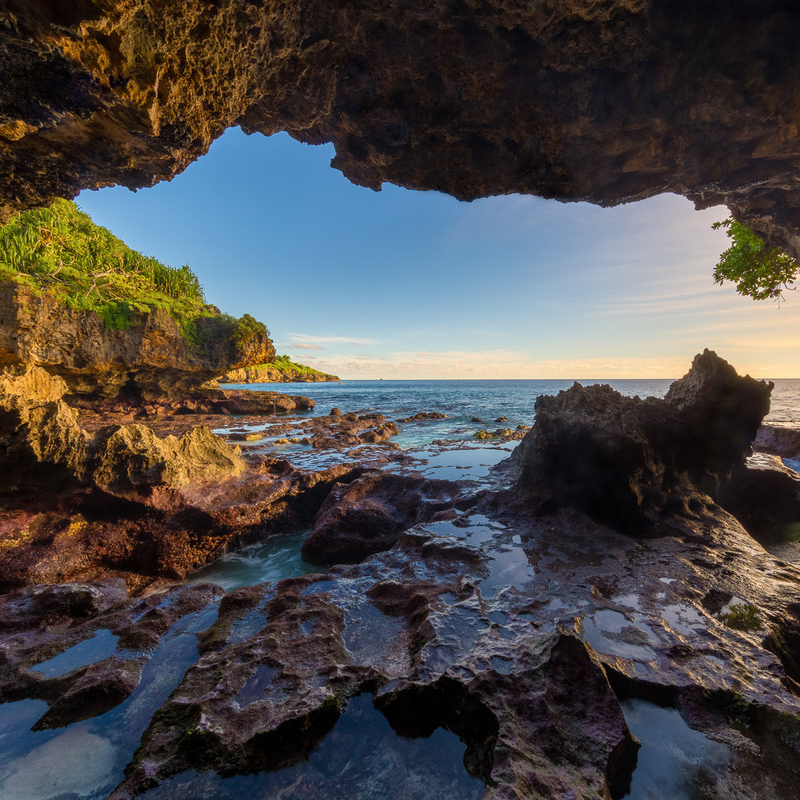
Like King Kong’s Skull Island, Christmas Island is the land time forgot. Uninhabited for thousands of years, Christmas Island became an Indian Ocean Galapagos. There are species here you won’t find anywhere else in the world.
Videos by TravelAwaits
Christmas Island is in the Indian Ocean closer to Indonesia than mainland Australia. Despite the location, Christmas Island is an Australian territory reachable on a three-and-a-half-hour flight from Perth.
The island came into being when the peak of a steep basalt volcanic seamount rose over three miles from the ocean floor about 60 million years ago.
Captain William Mynors named Christmas Island on Christmas Day in 1643 from aboard an East India Company vessel. But steep cliffs and impenetrable jungle continued keeping the world at bay.
When rich deposits of phosphate were discovered there in the late 19th century, Britain annexed the island. Soon after, the Christmas Island Phosphate Company brought in Chinese indentured laborers, Sikh overseers, and a small number of Malays — the beginning of the island’s diverse cultural mix.
Even today, the 50-square-mile tropical island remains unspoiled by mass tourism. Tracks and trails reach the most spectacular locations, but the island is still covered by tropical rainforest, two-thirds of which is a national park.
Christmas Island is the place to swim with whale sharks, bathe under waterfalls, snorkel in clear waters, and spot rare birds. And for anyone fascinated by crustaceans, you have found crab heaven.

1. Crabs Cross Here: The Sight Of A Lifetime
Nature documentaries recording Christmas Island red crab migration have captured the imaginations of people worldwide. David Attenborough described the experience as one of the most memorable of his life’s work. There are around 45 million red crabs on Christmas Island, all fire truck red and around 4.5 inches wide. Imagine the start of the wet season in late October and November when they march like a red army from the jungle — trekking several days to mate on the beach. Locals protect them on the roads as best they can; keeping rakes or brooms in their cars for gentle sweeping out of harm’s way. So much kinder than the sickening crunch. Some roads are closed to allow safe passage. Where they remain open, rangers place railings along the edges, funneling millions over the overpasses built specifically for them. They climb up and over like soldiers scaling obstacle courses. Not surprisingly, these bridges are a huge hit with tourists.
The female crabs stay in their burrows for a couple of weeks. Then, they spawn en masse — dropping their eggs into the water where the larvae develop. In February they hatch, and tens of millions of baby crabs crawl toward the jungle, creating a moving crimson carpet that blankets streets, the golf course, and anyone’s shoes that happen in their way. Wise locals seal up door openings.
If you visit outside these migration times, there are still plenty of crabs to see. Christmas Island has 20 species of land crabs and you become strangely accustomed to their presence. They include the Christmas Island blue crab — with its striking blue hues — and the coconut crab, the largest land-living arthropod in the world, also known as the robber crab. Watch out for your camera. They love carrying off shiny objects.

2. Enjoy Mother Nature’s Outdoor Spa
No need for expensive spa treatments on this holiday. Christmas Island offers a variety of “treatments” for free. After a forest boardwalk in a tropical dale, immerse yourself under rainforest falls at Hughs Dale Waterfall — the ultimate Vichy shower. Dip in the Grotto with a pure white sand base and crystal blue water. The ocean swirls to meet a subterranean freshwater stream with you in the center. Enjoy nature’s flotation tank. With its much higher roof. Climbing in is tricky. But worth it if you can. Cool off at the Blowholes. Waves crash at the base of a honeycomb of eroded cliffs — forcing seawater high in the air. There’s a loud whoosh and eruptions like a windpipe of volcanoes venting steam. This drifts toward you as a delightful cool mist. A spa might call it a hydration therapy. Bathe in natural infinity pools and a spa carved by nature. Waves crash over tiered rock pools, spilling over edges like miniature waterfalls. This ocean spa is close to Swell Lodge — a new, upmarket eco-lodge where guests even have their own chef.

3. For Glorious Deserted Beaches
Christmas Island offers many beaches where you can relax or frolic in the shallows. Experts voted Dolly Beach the seventh best beach in Australia in 2016. After a scenic 1.2 mile boardwalk, you are greeted with a scene from Robinson Crusoe. Palm trees angle over pure white sands lapped by turquoise water. Man Friday left no footprints, but plodding turtles have. While secluded, I wouldn’t swim naked. It’s not allowed, for a start, and a robber crab might just steal your clothes.
Another boardwalk runs between Lily Beach (a tidal rock pool for swimming) and Ethel Beach (a great place to view fossils). The blowholes are along this stretch. Most of Christmas Island’s 50-mile coastline is dominated by sea cliffs — the gaps creating hidey-hole beaches waiting to be discovered. Merrial Beach is so tiny it disappears at high tide. It’s much loved by photographers who trek out for the perfect shot of white sand and blue ocean framed by rock formations.
For serious swimmers, the southern end of Flying Fish Cove offers a protected ocean setting.

4. To Explore An Underwater Paradise
Instead of traveling miles out by boat to see coral, Flying Fish Cove offers world-class snorkeling a few feet from shore. A narrow fringe of reef encircles the island and is home to 88 different species of coral and 600 colorful species of tropical fish. It’s a magical world of sea urchins, clams, and darting arrows of fish — and a chance to see turtles, manta rays, giant trevally, lionfish, and spinner dolphins.
The island rises dramatically from the edge of the Java Trench, the Indian Ocean’s deepest point. So even 20 yards out, serious divers can enjoy spectacular wall dives and larger fish. Between October and January, this includes whale sharks, the world’s largest fish. They can grow the size of a school bus with mouths more than three feet wide. These gentle giants feed on plankton, so it’s safe to swim with them. They arrive seasonally to feed off the billions of larvae released during red crab spawning.
Christmas Island has more than 60 dive sites. There are wall and reef dives, underwater caves, hybrid fish, and unusual species rarely found elsewhere. Wet n Dry Adventures is a family business operating since 1994 and Extra Divers is a global brand that offers diving experiences. With excellent visibility and warm water, Christmas Island is an ideal place to gain diving certifications.
Christmas Island is also an important fishing destination, offering everything from dropping a line off the jetty at Flying Fish Cove to deep-sea game fishing. Giant trevally, wahoo, yellowfin, and dogtooth tuna are some of the larger species.

5. For A Twitching Good Time
Everyone becomes a birdwatcher (a twitcher) on Christmas Island. Birds are everywhere. The terraced island is a tropical seabird rookery, with around 80,000 seabirds nesting here each year. A short drive through plateau forest leads to the boardwalk at Margaret Knoll Lookout where many of Christmas Island’s varied bird species soar past at eye level showing off their aerial acrobatics. You’ll see golden bosuns with yellow plumage and dive-bombing frigatebirds. Male frigates have throat pouches. They inflate their pouches during mating season to attract females. These look like huge red balloons. There are many red-footed and brown boobies. There’s even a good chance to see a rare Abbott’s booby; they nest nowhere else on Earth. These crazy-looking creatures have huge webbed feet (imagine birds wearing colorful flippers) and can perch firmly onto anything. They hold no fear of humans. You can get close for some great photographs. At National Park Bird Feeding, watch volunteers feed rescued Christmas Island birds. Birdwatchers come to Christmas Island from all over the world either independently or on bird watching tours.

6. For Melting Pot Flavors And Cultures
Christmas Island has a harmonious blend of Buddhist, Christian, Taoist, and Muslim residents. Of the 2,000-strong population, some are also from mainland Australia.
Expect Taoist temples and shrines overlooking the ocean, and a shining mosque in Kampong, the island’s traditionally Malay neighborhood.
Ethnic diversity means surprising food finds. Head to the Idah Kitchen at the Malay Club for a traditional breakfast of noodles, laksa, or Hainanese chicken rice washed down with teh tarik — tea with condensed milk. Lucky Ho serves Sichuan classics and dragonfruit slushies. The Chinese Literary Association spices up life with Asian fare. Rumah Tinggi Bar and Grill is home to excellent tapas and sundowner drinks with clifftop views. Golden Bosun Tavern offers good pub grub. It is also the place to chat with the locals over a beer and sunset views.
Seafood is plentiful, but crabs are protected and off the menu. Eating out is more expensive than at home as the soil lacks nitrates so fresh produce is mostly freighted in. But as a tax-free zone, alcohol is some of the cheapest in Australia.

7. History Buffs Won’t Be Disappointed
Christmas Island has a fascinating, if harsh, cultural history. Early phosphate mineworkers were treated cruelly and died in the hundreds. During WWII, islanders were shipped to Japanese prisoner of war camps in Indonesia after they sabotaged the mine. A strong Union of Christmas Island Workers was necessary to improve living and working conditions on the island. And Christmas Island has at various times been the contentious site of an immigration detention center. Tourists can find out more about Christmas Island’s history at Tai Jin House, where a historical exhibition tells the full story (open daily 12 p.m. till 3 p.m.) or by chatting with long-term locals. With scaling back phosphate mines, ecotourism on Christmas Island is set to boom. Don’t expect a tropical resort, but your forays into nature will be unforgettable.
Pro Tips
Christmas Island is safe. There are walking trails and boardwalks to suit all fitness levels. But follow hiking guidelines. Personal Locator Beacons are available from the Christmas Island Police Station.
You need a 4WD vehicle to reach some attractions. Collect from the airport. Or tours are available.
Not all accommodation is advertised online. Contact Christmas Island Visitors Centre for additional recommendations.
With incredible wildlife and scenery, and opportunities for underwater photography, there’s a number of photography tours.
Visiting Christmas Island is often combined with a trip to Cocos (Keeling) Islands — another Australian territory and a tropical paradise. In normal times, flights operate from Jakarta as well as Perth.
Looking for more travel inspiration? Here’s why Australia’s outback or rainforest should be on your bucket list.
Editor’s Note: The ideas about Christmas Island presented in the first paragraph of this article are inspired and informed by “Close encounters on Christmas Island, Australia’s own Galapagos,” an article published by the Christmas Island Tourism Association.
